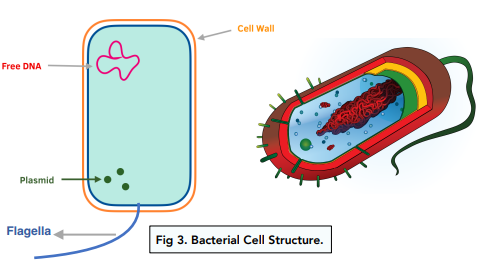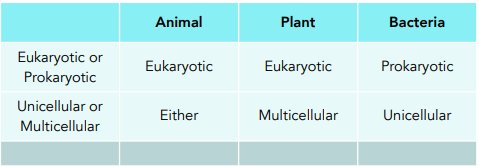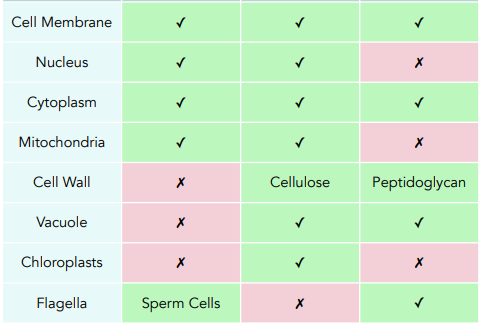Introduction to Cells - Bacterial Cells (GCSE Biology)
Bacterial Cells
Bacterial Cell Structure
Bacterial cells have all of the organelles that plant cells do, except for a true nucleus, chloroplasts or mitochondria.
Cell wall – The cell wall is not made of cellulose, but is instead made of peptidoglycan.
Free Chromosomal DNA – Bacterial cells have DNA free in the cytoplasm. It is single-stranded, unlike DNA in a nucleus which is double-stranded.
Plasmid DNA – Some bacteria have small circular loops of DNA in the cytoplasm called plasmids.
Flagella – Some bacteria have a long hair-like structure that rotates to help the bacteria propel forwards and move towards nutrients or away from harmful toxins.

Some bacteria can carry out photosynthesis but they mostly feed off other organisms living or dead.
Examples:
• Lactobacillus bulgaricus – this is a rod-shaped bacterium used to produce yoghurt from milk.
• Pneumococcus – a spherical shaped bacterium that acts as a pathogen and causes pneumonia.
Animal, Plant and Bacterial Cell Comparison


FAQs
Cells are the basic unit of life. They are the smallest structures that perform all the functions necessary for life.
Bacterial cells are a type of single-celled organism. They are different from other cells because they have a simple structure, lack a nucleus, and reproduce through a process called binary fission.
→Are bacterial cells eukaryotic or prokaryotic?
Bacterial cells are prokaryotic because they do not have a nucleus within a cell membrane. They are unicellular.
The cell wall of bacterial cells are what gives the cell its shape. The cell wall is the same thickness all around the cell and holds in the plasma membrane.
Bacterial cells do not have a nucleus and lack the genetic material that is found in eukaryotic cells. They also do not possess the same membrane structure that is needed to hold a nucleus.
Unlike eukaryotic cells, bacterial cells do not have a cell membrane. Instead they have a plasma membrane.
Binary fission is a process by which bacterial cells reproduce. During binary fission, a single cell divides into two identical daughter cells.
The cell wall in bacterial cells serves as a protective barrier that helps to maintain the shape and stability of the cell. It also helps to prevent the cell from being damaged by the environment.
The cytoplasm in bacterial cells contains all the necessary components for life, such as enzymes and other organic molecules. It is where the metabolic processes of the cell take place.
The flagellum in bacterial cells is a whip-like structure that helps the cell move. It acts as a propulsion system, allowing the cell to move towards nutrients or away from harmful substances.
The pili in bacterial cells are hair-like structures that help the cell adhere to surfaces. They also play a role in bacterial reproduction by allowing the cells to stick together during binary fission.
Bacterial cells are important because they play a crucial role in many different processes, such as breaking down organic matter, fixing nitrogen in the soil, and producing antibiotics. Some bacterial cells can also cause disease, so it is important to understand their structure and function in order to prevent and treat illnesses.






Still got a question? Leave a comment
Leave a comment